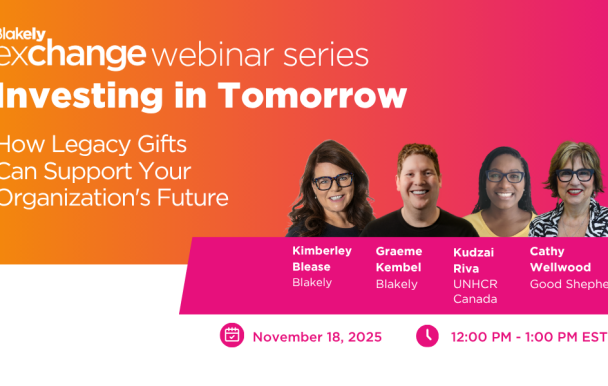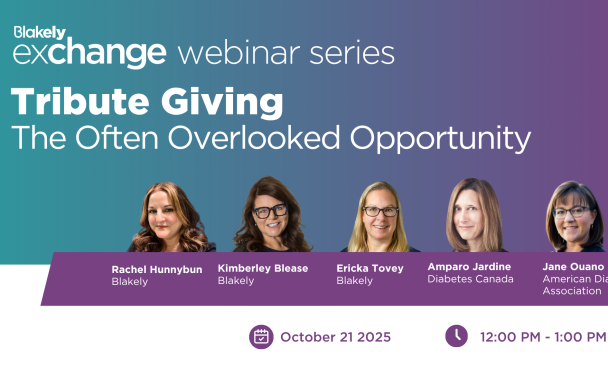The Transformative Power of Legacy Giving
The global pandemic has forced everyone to think about their fundraising portfolio, and for many, it’s all about the short-term. But fundraising leaders must always look at short, medium, and long-term income in order to ensure diversification and the management of risk.
There has always been a powerful case for investment and focus on Legacies, and this has been intensified as we move through this crisis, emphasizing the need to invest in a Legacy program.
So, what can we do now that will make the difference in recovery and long-term growth?
We believe one big step is to build transformation through a fundamental shift in focus to legacy conversations.
In this week’s webinar, we explored Legacy Giving in the time of COVID-19 and how we can look to the future by taking action now. Stephen George, UK Legacy Fundraising expert, and a special guest on the webinar shared responses from a recent poll of legacy fundraisers. The poll demonstrated that 29% had simply stopped marketing entirely, and 40% had changed their program or canceled elements of it. On a good news front, at least 23% were creating a new approach.
To better understand what fundraisers were doing to connect and support legacy, we conducted a review of 50 charities in Canada, the US and the UK and found that almost all legacy web pages did not even mention the crisis. This, despite the record number of wills being written and the use of websites as a key source of information for people on the causes they care about (in fact, 20% of the sites reviewed were a challenge to even find legacy information on!).
Context and connection with donors are at the heart of great legacy fundraising, so it makes perfect sense to update web content with a supportive message of empathy. After all, donors are just like you and me. They are struggling for connection and a way to take positive action, and many more are thinking about a gift right now. A dialogue with supporters is a powerful connection. It’s not selling — It’s empathy.
As we look forward to building for recovery and beyond, what are the key areas we can focus on?
If we are to create a new conversation around legacies, we need to create a new understanding and invite people in to explore that with you. That means a new strategy for engaging your entire organization in legacy giving – your donors, directors, boards, colleagues and your front line.
For many who have legacy giving siloed, or only integrated with major gift or non-existent – it means a major shift in focus, investment and culture. It means doing things differently and it means realizing a major opportunity to truly connect with people based on your core mission and values.
We believe there are 10 powerful conversation starters for you internally, as you embark on a new approach to legacy giving. These include:
- How can we put the supporter first and at the centre?
- How can we shift thinking to influencing behaviour and giving rather than creating a sense that we are selling?
- What do we need to do, to integrate legacy fundraising into everything we do?
- How can we reframe the way we measure impact, outcome and expectations?
- How do we build connections and conversations, so people can consider first and action second?
- How can we build personal connections and an integrated, inspiring journey?
- What content do we need to create and share to engage and inspire?
- What channels do we have and what are we missing?
- What culture do we need where legacies are normal, embraced, understood, and supported?
- What do we need to do, to be more aspirational and ambitious?
Creating a conversation around legacies is a start to a transformation and there is no better time than now. This crisis has prompted charities and NGO’s to take a look at their fundraising portfolio and realize that legacies, with the best ROI in fundraising and the best opportunity at the moment, need to be done deliberately and strategically. A first step is to define 4 key steps for a better program:
- Find Purpose – Clearly define the problem, the opportunity and case for a program or a change in the program. Setting out a clear purpose and defined aspiration will galvanize people, and once pointing in the same direction, you can create the next steps.
- Build a Strategy – Too many programs find tactics ahead of strategy – strategy leads, so build powerful insights and principles and a clear strategic framework around your aspiration.
- Create a Plan – A plan to deliver your strategy and purpose. Create the key goals, channel mix, tactics and activities – articulate your donor journey and how you will integrate legacy with other key revenue areas like annual and major gift.
- Investment – Create your investment plan and building blocks. You can build a real program that allows you to position your organization and do more to engage your audiences in your vision.
It’s time to start a legacy conversation that can spark a real transformation – for you, your organization, and your supporters who care so much about your cause. The question is, how much growth do you want to drive through legacy giving for your organization in the future? The answer to this will help guide your investment of time and energy today!









